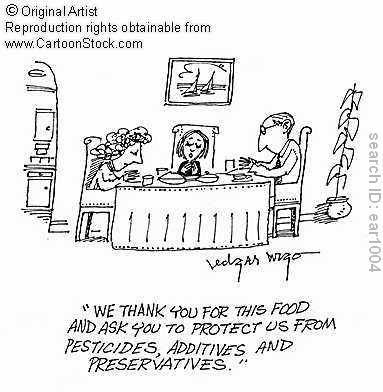
© cartoonstock.com
If you've been hearing a lot about food additives lately, it's for good reason. They are in pretty much everything on store shelves these days, but I am willing to bet most people do not understand exactly what they are. And you may wonder why you even care. Well first of all, as I mentioned, additives are in almost every box, bag, jar, or can of packaged food you buy at the grocery store. So, what are additives?
The basic and most simplified definition of a food additive is anything added to a food to improve its taste, color, or shelf-life. Additives have been around for centuries. I'm sure most people are familiar with the process or brining meat with salt, which was the first way to preserve meat before refrigeration, or with pickling, which is basically a way to make vegetables last longer. These methods were all natural; however, in today's world of mass-produced food and mega-grocery stores, producers have to find ways to make food last longer and look more appealing. This is where artificial additives come in.
Additives come in so many types and varieties, it is sometimes hard to keep them straight. There are acids, coloring agents, emulsifiers, de-caking agents, preservatives, bulking agents, flavor additives, and the list goes on and on...and therein lies the problem. It is estimated that around 3,000 different additives are put into our food before it hits store shelves. (For a list of these, click
here.) As Americans buy more and more packaged, prepared, and processed foods, they intake more and more of these additives. And while the FDA says that they are "GRAS," Generally Recognized As Safe, it is difficult to know the true long-term effects of these additives as we consume them in larger and larger quantities. And we all know that the FDA is overworked and underfunded, so how great of a regulatory job do they actually do? And the term "generally recognized" does give me quite the reassurance I would like. Why not, "Definitely Deemed Safe" or "Approved as Safe." It kind of feels like the FDA doesn't want to commit to their endorsement of these additives and chemicals. There have been recent studies lately that have indicated that certain food additives can actually have negative effects such as hyperactivity in children. And one food additive you may be familiar with, monosodium glutamate (aka MSG), which is used with abandon in many Asian foods and most fast foods, can cause headaches, bloating, and even upset asthma. This additive is a great example of something that started out as a natural preservation method: Asian cultures used the MSG naturally occurring in seaweed to preserve their foods, but quickly turned into a test lab additive once scientists discovered how to create MSG from bacteria fermentation. The problem here is: who's to say if scientifically engineered MSG will have the same effects on people as that occurring naturally in nature? This is my dilemma with all chemically created and engineered food additives.
It seems to me that any food containing an acid or some other agent created in a lab in order to make a food more appealing or marketable needs to be looked at with caution. First of all, why is the food not appealing enough on its own? Secondly, do we really want food on the shelves created and manufactured to "live" longer than it is supposed to. There's something worrisome to me about a box of food that has more staying power than the people eating it.
So how do you know if your food contains additives? Here's a hint: if you are buying it in a box, bag, carton, jar, can, bottle, or other form of packaging, there's a 99% chance it contains some sort of additive. Additionally, if you can't pronounce it , it's likely a food additive. If it has the word acid in it, it's likely a food additive. If the sodium levels are sky high, it's likely a food additive.
The point is to beware of what you are buying. As has been said over and over again, if you stick to fresh, whole foods, you can cut down on your family's consumption of chemically processed and altered foods. A peach from the produce department is not going to contain an additive, but a can of peaches in heavy syrup from the can goods aisle most likely will. And when buying meat, look for all natural, no preservative messaging on the labels. My personal rule of thumb is to spend the majority of your time on the outer edges of the grocery store, in the produce section. Once you venture into the aisles with the packaged foods, your additive content is going up. Some food for thought...the more colorful the package, the more likely you're eating more than you bargained for.
and dont let the monkeys feed you and make a monkey out of you. peace